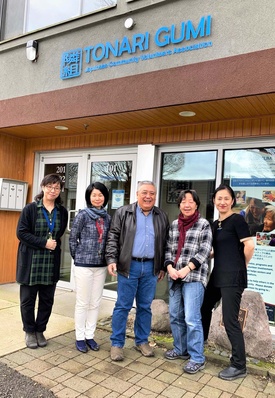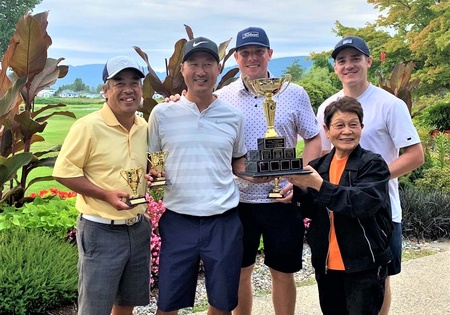What are some of the challenges of operating Tonari Gumi (TG) during a pandemic?
From 2010 to 2015, I worked full-time as the executive director of the Japanese Community Volunteers Association, or Tonari Gumi, as it is popularly called in Japanese. Tonari Gumi had always had a positive image in the Japanese Canadian community ever since it started as a small group of young volunteers wanting to help poor and isolated Japanese Canadian seniors in the Downtown East side of Vancouver in 1974.
The original founder was a young Sansei from Ontario who had come to study in Vancouver by the name of Jun Hamada. He soon teamed up with a mélange of other young Sansei and young newly arrived Japanese immigrants, such as Takeo Yamashiro (who became the first executive director) in trying to help the seniors who had found themselves back in the old Japan Town part of Vancouver after the end of the internment, looking for the Japanese community which was no longer there. Many of them didn’t speak adequate English and were isolated and not able to benefit from many of the benefits to which they were entitled.
Tonari Gumi has evolved significantly since those early days, but is still involved in trying to help seniors, only now the focus is on first-generation post-war Japanese who also needed help in adjusting to life in Canada. When I started as executive director in 2010, TG was located in a small, rented facility on East Broadway. In 2012, we were able to purchase our own three-storey, 8,900-square-feet building at 42 West 8th Avenue, just west of Main Street in the Mount Pleasant area. Although now no longer in East Vancouver, TG is still not far from its original roots, but situated next to the under-construction Broadway subway line and more easily accessible via public transit.
As for community leaders, there are probably four or five main loci within the community:
-
The Nikkei National Museum and Cultural Centre (NNMCC) located in Burnaby and probably the largest Japanese Canadian organization in B.C. There’s been a recent changing of the guard at Nikkei with the current President and Board Chair, Herb Ono, a prominent lawyer with McMillan LLP. The executive director is Karah Goshimon Foster, a Sansei and the curator and Museum head is Sherri Kajiwara, also a Sansei.
Also included with Nikkei Place is the Nikkei Seniors Health Care & Housing Society with Ruth Coles as Board Chair and Jay Haraga as executive director. The Nikkei Seniors Health Care & Housing Society is a key player in the Japanese Canadian Survivors Health & Wellness Fund provided as part of the BC Government’s Redress initiative; - Vancouver Japanese Language School and Japanese Hall is the only significant Japanese Canadian facility located in the old Japan Town part of Vancouver. They’ve recently had a major change in their management with the new Board Chair, Tomonari Machida, and Executive Director, Darius Maze, newly hired about 10 months ago. Not sure about their current direction.
- The Japanese Community Volunteers Association or Tonari Gumi, with me as Board chair and Keiko Funahashi as executive director. Prominent members are Lurana Kikko Tasaka, Henry Wakabayashi, Larry Okada, etc.;
- Steveston Japanese Canadian Cultural Centre with Kelvin Higo as leader; and
- The Greater Vancouver Japanese Canadian Citizens' Association (GVJCCA) with Cary Sakiyama as Board President.
Many of these individuals are very new in their positions and so it remains to be seen as to how active these various organizations will be going forward. There are other groups outside of the Japanese Canadian orbit, such as the Konwakai (Japanese business group), Canada-Japan Society of BC (another business group with heavy focus on the Canadian players), plus the various churches and cultural organizations.
The biggest challenge in operating TG during the pandemic have been the restrictions on having in-person activities. Between March 2020 and September 2021, we were not able to have any in-person activities or gatherings at TG beyond more than two or three people at a time. In 2019 we had five full-time staff and two part-time staff and in March of 2020 we were down to three full-time staff working mostly from home and no part-time staff.
The staff and volunteers did an admirable job of staying in contact with most of our seniors and those who were most vulnerable, but it was a difficult task with significant negative impacts on the mental health of our seniors.
Ironically, fund-raising was not as serious a problem as we had anticipated despite the fact that almost all of our major fund-raising events had to be canceled. The only one that we were able to continue throughout was our annual golf tournament together with the GVJCCA. However, we were able to take advantage of many of the emergency government funding programs and we made a major appeal to our donors and a number of them came through in a big way.
We were also the recipient of a major grant from the United Way of the Lower Mainland, which enabled us to maintain many key programs to assist seniors —only we did them on-line and through the delivery of bento meals to isolated seniors via volunteer drivers. In September 2020, we were able to rehire most of our former staff and even hire some new ones.
We are currently back to five full-time staff and two part-time staff, helping seniors to stay in contact with their medical professionals, delivering bento lunches, and helping seniors to stay mentally alert and in touch with others. Some limited in-person activities were re-started this September and we hope to continue expanding them as pandemic restrictions are gradually lifted.
From a governance point of view, not being able to meet regularly, except via zoom, with our board members and key volunteers has changed the collegial atmosphere at TG. Regular congregant meals are a major part of TG’s activities and not being able to hold them on a weekly basis has restricted social inter-activity and isolated many of our seniors. Our expanded bento delivery services have helped, but do not substitute for being able to socialize together.
Do you have any idea about how many people you serve? What is the split between Ijusha and the older Japanese Canadian (JC) community?
We generally average around 300 members (those who pay our annual membership fee of $40 per year) and roughly 200 volunteers (although with our not being able to hold many events over the past nearly two years, it’s difficult to be sure how many active volunteers we still have). In addition, we have a further 50 or so individuals who attend many of our activities as non-members and we provide services to many seniors who are not members.
In general, I’d say that we interact with between 400 to 600 different seniors and other community members on a regular basis. More than 70 seniors subscribe to our weekly bento delivery service. Our monthly newsletter is distributed to about 700 individuals via email and some hard copies and so that would indicate our reach within the community.
As for the split between Ijusha and pre-war related JCs, I would say that Tonari Gumi’s clientele is overwhelmingly post-war Ijusha, probably close to 80 per cent with the remainder being from the older JC community. When we were surveying our membership to identify those who were WWII internment and evacuation survivors, we could only identify some 70 survivors from within our membership and volunteers of around 500 people. A further 30-40 members and volunteers would be Sansei and younger members of the community.
For the Japanese Canadian Survivor Health & Wellness Fund program funded by the BC Government as part of its BC Redress initiative, TG is partnering with the GVJCCA and the Steveston Community Society to increase its engagement with the older JC and survivor community.
Do you extend your services to the greater/non-JC community?
Up until now, with most of our services and activities focussed on the Japanese-speaking part of the community, we have not extended many of our services to the greater/non-JC community. We do have some Japanese speaking Taiwanese and Korean seniors who participate in our activities and register for our bento delivery, but there are only about three or four at last count. We have had joint training programs for our volunteers which we have conducted with the Vancouver Jewish community and our hope post-pandemic is to expand these joint training and other activities with various non-Japanese community groups.
How accessible is TG to the demographic you serve? Can you please describe the location and neighbourhood?
Accessibility is a major challenge for TG for three different reasons:
-
Our clientele are aging rapidly and so are less mobile than in the past, making it difficult for some of them to attend our activities. During the pandemic, some of those who are still mobile became reluctant to use public transit due to Covid-19 concerns.
-
The excessive escalation of real estate prices in Vancouver, Burnaby, and Richmond have resulted in many Japanese Canadian families moving further out into the Lower Mainland, either because they sold their residences in Vancouver to take advantage of the high prices or they can no longer live in Vancouver, Burnaby, or Richmond due to the higher rents, etc. In many cases, where the seniors live with their children or other family members, they have to move out into the suburbs with their family members. This has meant they are farther away and less able to attend our activities.
-
With many of our seniors shunning transit, they prefer to be driven or to drive themselves to various activities. TG’s location in the Mount Pleasant area means that there is very limited parking available, and TG does not have its own parking facilities. This limits some seniors from participating.
TG’s current location at 42 West 8th Ave. in Vancouver places us one block north of the Broadway corridor and two blocks from Main Street. We are close to the City Hall/Cambie station on the Canada Line and a short bus ride away from the Broadway/Commercial station on the Expo line of the Skytrain. There is also frequent bus service on both Main and Broadway. In a few years, the Broadway subway line will greatly expand transit access.
However, with some people shunning transit and our limited parking accessibility, some of our seniors find it more difficult to get to TG. We have recognized these challenges and prior to the pandemic we were holding some of our activities in other locations in Steveston, in Surrey, and in Port Coquitlam to be closer to our seniors. Our hope post-pandemic is that we will be able to resume these activities and to “Reach Out” to more of our seniors who live outside of Vancouver.
© 2022 Norm Masaji Ibuki







